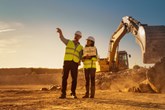How virtual prototypes have transformed mining equipment design
Published by Will Owen,
Editor
Global Mining Review,
Pär-Ola Jansell, Vice President and Global Technical Lead for Heavy Equipment, Trucks, and Rail, Altair, explores how virtual prototyping – powered by simulation, AI, and data analytics – is revolutionising mining equipment design by boosting innovation, reducing costs, and accelerating development with real-world applications.
For most of its history, the mining industry has relied on physical prototyping to design its heavy equipment. However, with the maturation and convergence of simulation, data analytics, and AI, the industry is witnessing a paradigm shift, with virtual prototyping at its core. This article will explore how virtual prototyping will transform the design of heavy mining equipment – and how it is already doing so.
More innovation, less headache
The world of virtual prototyping is complex – there are more vendors, platforms, tools, and capabilities than you can count. But luckily, virtual prototyping’s value proposition is simple: do more with less, increase innovation, shorten time to market, reduce risks, and slash costs.
In mining equipment design, the technologies that deliver this value include finite element analysis (FEA) and discrete element method (DEM) – paired with robust data, AI, and digital twins. These technologies enable engineers to evaluate and verify designs much faster and more accurately than ever before – without needing to run costly physical tests. Leveraging them, teams can solve more complex problems in interesting ways; they can reduce waste, risks, and costs; they can make, simulate, and optimize more interesting designs; and they can experiment with a freedom that yesteryear’s physical prototyping-driven landscape did not allow.
Not just buzzwords or concepts for the future, modern virtual prototyping tools and platforms are already driving the mining industry’s digital transformation.
Real-world uses and impact
There is already a myriad of virtual prototyping use cases to explore at every step of the mining equipment design life cycle. They allow teams to predict the flow behaviour of rocks, ores, and coal through each segment of their equipment and operation. They also empower engineers and designers to build stronger, more durable, more sustainable equipment. And they do all this faster, more efficiently, and more accurately than physical testing.
For instance, once trained, AI-powered geometric deep learning tools can deliver predictions up to 1000 times faster than traditional solver simulations, slashing simulation runtimes from hours to seconds and what-if studies from months to days. Teams can use this to quickly simulate the flow of materials through transfer chutes, jaw crushers, and more, alongside testing new components and systems within vehicles.
Teams can also use DEM simulations to analyse the discharge of bulk materials on a belt feeder, investigate material breakage in cone crushers, model vibrating screens and milling heads, and simulate the charging of blast furnaces.
Mining’s next innovative leap
Looking ahead, AI and digital twins in particular are set to help break new ground in mining equipment design. These capabilities will help organisations better maximise equipment performance, slash costs, improve designs, and deliver real-time insights that minimise downtime and warranty expenses.
And beyond mere simulation, AI will mark a new era of innovative risk-taking in design. AI agents – powered by knowledge graph technology – can be used to optimise workflows, improve the customer experience, and enhance productivity, scalability, and decision-making in supply chain operations, fleet monitoring, and beyond.
Lastly, these tools help teams get the most from their investments and see the big picture in one go. Rather than simulating mere components and systems, teams can now simulate entire systems of systems – analysing electronic, mechanical, and thermal performance all in a single, unified technology environment free from walled-off knowledge silos.
Though the adoption and growth of new technology always presents new challenges, virtual prototyping is already fostering the creation of stronger, lighter, more affordable, and more sustainable mining equipment. Those who leverage it early and effectively are poised to see significant commercial advantages.
Read the article online at: https://www.globalminingreview.com/mining/25042025/how-virtual-prototypes-have-transformed-mining-equipment-design/
You might also like
Data goldmines: Advanced analytics optimise brownfields in uncertain times
Jane Marsh, Editor-In-Chief at Environment.co, explores how advanced data analytics and digital technologies can revitalise brownfield mining operations, enabling resource companies to boost yield, reduce costs, enhance safety, and extend mine life.


